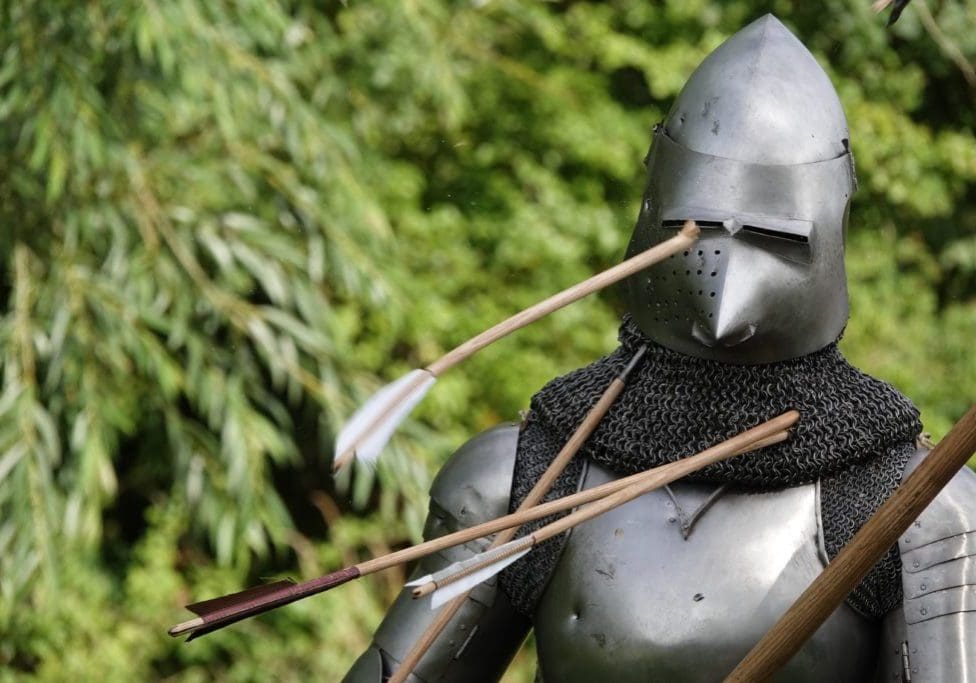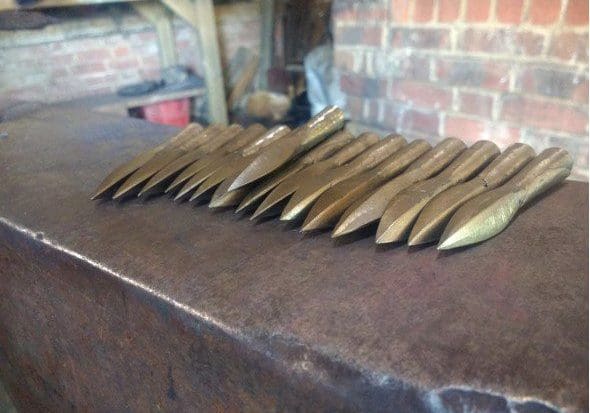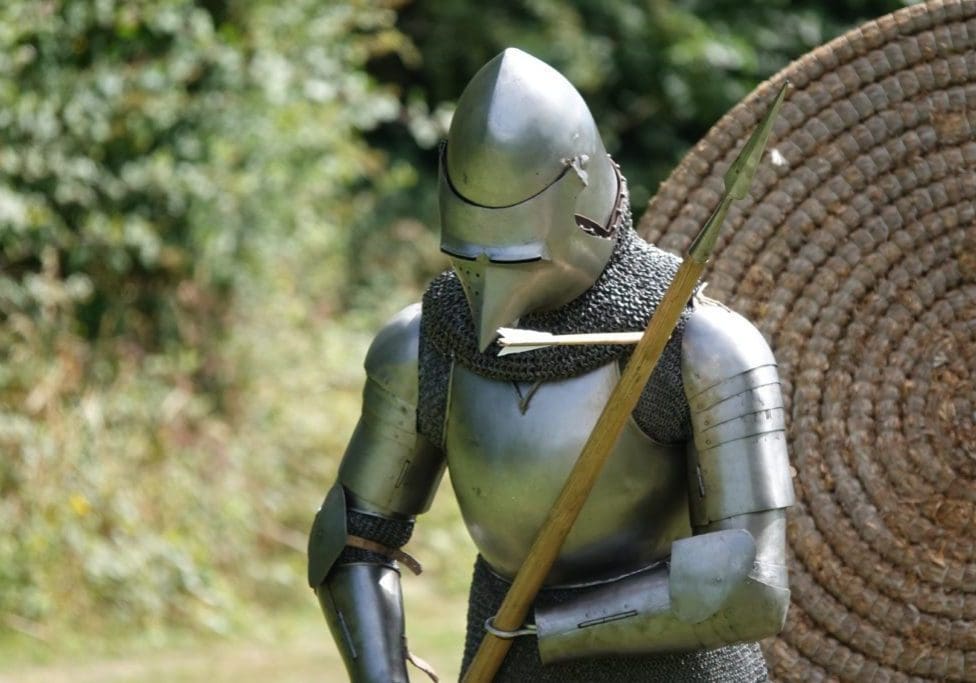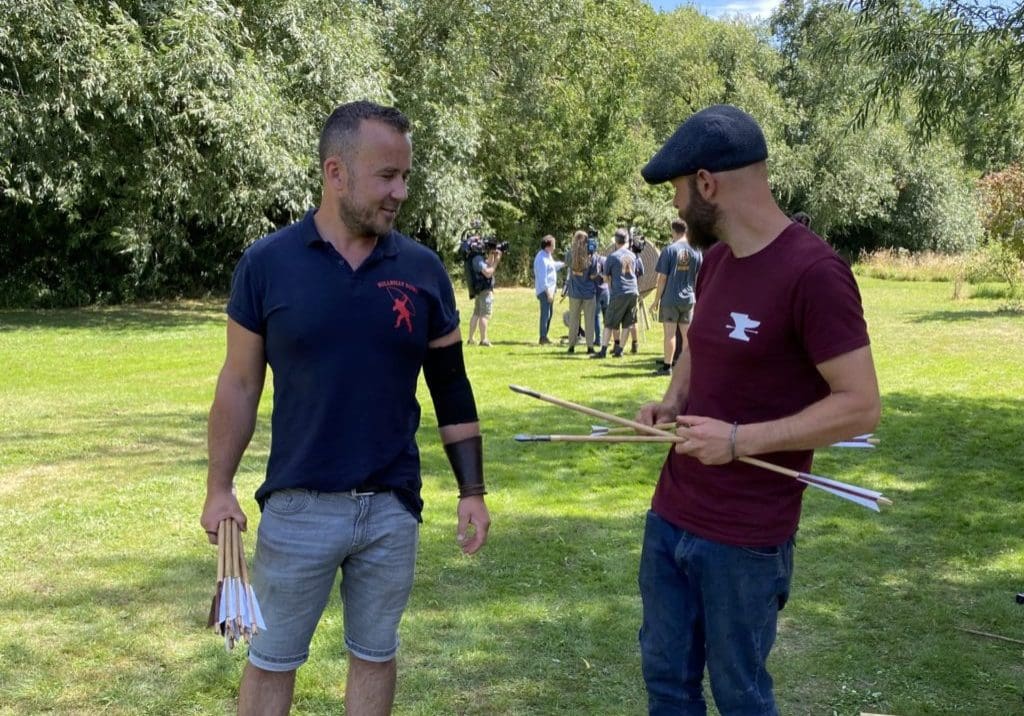Plate armour material test
Plate armour material test
Which armour material?
Armour was made from different materials and of different qualities. At the time of Agincourt most armour on lesser men was still of a low carbon iron or steel, though higher status individuals would often have a medium carbon steel such as that of the Churburg 14 breast plate that we based our first film on.
Many of you will know the difference between iron and steel and that difference is important. Simply put, steel is an alloy of iron and carbon. It also usually contains other trace elements absorbed during the manufacturing process. The presence of carbon means that the metal can be heat-treated to increase its hardness, and also tempered to increase toughness (although tempering reduces hardness somewhat). In the mid 14thC high quality armour started to be made from heat-treated medium carbon steel, which was much more protective than iron – so the armour could therefore be thinner, and a lot lighter, to provide the same level of protection, or it could be the same thickness, and much more protective.
We are trying to base our tests on a range of artefacts that are ‘normal’ and we have to acknowledge that perhaps the steel quality we used in the first film was perhaps a little bit too good for the average guy, so Augusto has made us a stunning breast plate in a low carbon steel of approximately 0.2% carbon.
Modern and medieval steels are different. They have different properties and we would have loved to make this armour out of medieval steels, but in the short term this is just not a realistic option, so this experiment will show how our test material compares to real medieval steels. If we had chosen medieval style steel, we would take the project a further couple of years into the future. However this is perhaps something we could consider another time.
So for the steel we are using a substitute and in this case it is the modern utility material, mild steel. It is important to note that we have original armour pieces of the same style and period, that are made from nearly pure iron, through to 0.6% medium carbon steel and pieces which are twice or even three times as thick as their contemporaries. Armour quality and material varied massively. We are using mild steel and that is not ideal, however according to the work of Alan Williams it is a good substitute in performance terms to low carbon medieval steel. CHECK THIS BIG TIME. So we can be sure that our armour is representative of some of the armour that was on the field at Agincourt.
However we want to understand as much as possible about how arrows strike armour and what happens and so we need to understand the relative differences between different materials when struck by arrows, so we have designed a simple test looking at the following materials.
Wrought iron from medieval bell clappers
Cross laminated wrought iron from medieval bell clappers
Bloomery iron
Cross laminated bloomery steel
Modern mild steel like we are using for our current armour
Modern 0.5% carbon steel like we used for our original breastplate
The modern materials are in the list for our and everyone’s reference so we can see how they perform compared to the medieval possible options.
These sheets are all nominally ground to 1.5mm thick and fixed using 8 points to a steel frame and then shot using an old compound crossbow that is being used as a ‘Longbow simulator’ because it shoots the same weight arrows at the same speed, but is more accurate. We will be using wrought iron type 9 heads on ash shafts. We are doing this because the small dimensions of the sample pieces requires accurate arrow placement. The sheets will be supported from behind on target foam.
We have seen that the arrows from the ‘Bow Simulator’ travel at the same speed as Joes from his 160lbs bow and even have oscillation like those from Joes bow, so I think they will give the same result, but even if you don’t, the relevance of the comparison of one material to another remains the same.
The test itself is simple and will show to what degree each material type is penetrated by the arrows so we can compare one against another. The steel is thin enough that it is likely the arrows will penetrate it, though probably not pass through so we can look at the size of perforation or depth of penetration to establish which materials perform better. We are using the sheet to show the relative difference, we are deliberately not using shaped armour as this would add a variability into the experiment.
This process will establish whether the use of mild steel is a reasonable choice and if it is likely to perform better, worse or about the same as a low grade armour steel of the time.
Notes
Realistically needs to be done in about 2.25 hours
Rob on main camera, Mike on Chronos and GoPros, Jon on reportage, Will or Joe on Panasonic (on tripod)
Front of camera crew to be Augusto and Tod. Tod is shooting
Shoot from 15m
Chronos will need to be close so we will need a side shield and a camera shield. Camera shield will have the option to fit a 8mm laminated glass plate or wooden plate with through hole for the lens. I think the chance of metal lens damaging shrapnel is low, but possible and think it would be prudent to use a glass shield.
If we take two shots at each sample that is 12 shots and a reasonable chance of breakage on each shot so lets assume we lose 6 arrows here but the heads may all or mostly snap off, so we need to think about collecting them if we can.
These arrows will also need to have the nocks removed for crossbow shooting and so destroyed for Joe. Lets modify 6 at this stage and we may well need them later in the main film anyway.
Having two frames will allow a crew member to swap out old samples and put in new to smooth the filming.
Infrastructure/kit
- Solid hide
- Camera hide
- 1 x go pro
- 2 x 18cm x 18cm frames in 50 x 50 x 3mm drilled and tapped M6, front face cropped to 25 mounted on back board of OSB and foam layers
- Samples ground to thickness cut and drilled
- 12 blocks of 90mm foam cut and dressed
- 6 wrought arrows – modified for the crossbow
- Wooden target stand
- 2 x back stop systems Material samples
- Wrought iron
- Laminated bloomery steel
- Laminated wrought iron
- Bloomery iron
- Mild steel
- Medium carbon steel.





